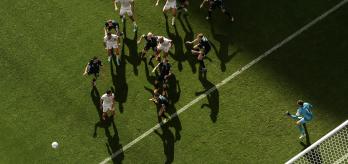There are many different ways in which a counter-press can be applied, but the two most common approaches are the individual counter-press and the collective counter-press.
Individual counter-press
The individual counter-press and efforts to win the ball back are often led by the player who lost the ball. This may eventually lead to more team-mates joining the press, but this tactic typically lacks the organisation involved in a collective counter-press and is often applied as high up the pitch as possible in an attempt to win the ball back immediately.
Summary
- The player who loses possession presses immediately to try to win the ball back or force a possession turnover.
- Applying an individual counter-press may entail a slightly less organised approach from a team perspective and fail to encourage team-mates to follow suit, but it nevertheless represents an aggressive method of trying to regain possession.
- Should the team in possession manage to play their way out of an individual counter-press, the (counter-)pressing team’s defensive organisation is less likely to suffer due to the number of players involved.
Collective counter-press
Some of the most successful teams in world football over the last couple of decades have been huge advocates of the organised collective counter-press. However, in recent years, coaches like Jürgen Klopp, Marcelo Bielsa and Thomas Tuchel have taken this concept to new levels, encouraging their sides to win the ball back both quickly and as high up the pitch as possible.
The counter-press or gegenpressing is a tactic that has been employed by an increasing number of teams around the world and is all about speed, intensity and high levels of organisation and fitness.
The approach centres on attempting to win the ball back in a more structured manner through a system that features a number of, if not all, outfield players. The idea is still to win the ball high up the pitch and involves closing down the space and options that the opponent has to play out to. Even if the initial counter-press does not result in the team winning the ball back, it may force the opposition to play a pass that they do not want to or pressure them into making a clearance and adopting a safety-first approach, which may lead to a possession turnover.
Summary
- A collective counter-press uses team triggers to win the ball back in a more structured manner, which typically involves identifying a target behind the press.
- High levels of intensity and aggression are required to close down space and stop the opposition from playing. Even if the team is unable to regain possession high up the pitch, this system may force a poor pass and a subsequent turnover.
- The counter-press may be led by the player who lost the ball but other team members are integral to closing the space in a coordinated manner, with the whole team applying a high press with a view to making the pitch small.
Key elements involved in reacting to losing possession
Aggression and intensity
It is often down to the player who loses possession to react instantly and attempt to win the ball back immediately. The speed of that reaction can determine the team’s chances of regaining possession. In addition, aggression and intensity in the reaction to the turnover can help to prevent the opposition from retaining the ball and developing play.
Anticipation
A key feature within the counter-press is anticipation and this is often focused on targeting the opponent’s weaknesses. Anticipating where a loose ball may break and identifying where the opponent may try to play the ball, whilst having the awareness to match the opposition up player-for-player in the collective counter-press, are all important elements.
Momentum
Adopting an aggressive approach to the counter-press can set the tone throughout the team, helping to keep the opposition on the back foot and retaining the momentum in attack if the ball is won back quickly. Not allowing the opposition to relax and build their own play can unsettle them and enhance the team’s chances of regaining possession quickly.
Overall summary
After losing possession, it is very common for the player who lost the ball to lead the counter-press in an attempt to force an immediate turnover. Regardless of whether the counter-press is applied by an individual player or collectively, an increasing emphasis is being placed on how quickly possession is recovered on account of the benefits to be gained from successfully implementing this approach.
Counter-pressing with intensity and aggression is key to winning the ball back and doing so high up the pitch can enable the team to immediately launch another attack in an advanced position. Doing so in a unified manner, with three, four or potentially more players, can yield even greater rewards as it means that several players are in a good position to reinitiate an attack. If implemented correctly, it can prove to be a highly efficient tactic. Indeed, at the very least, it denies the opposition the time and space to build a phase of possession.

























